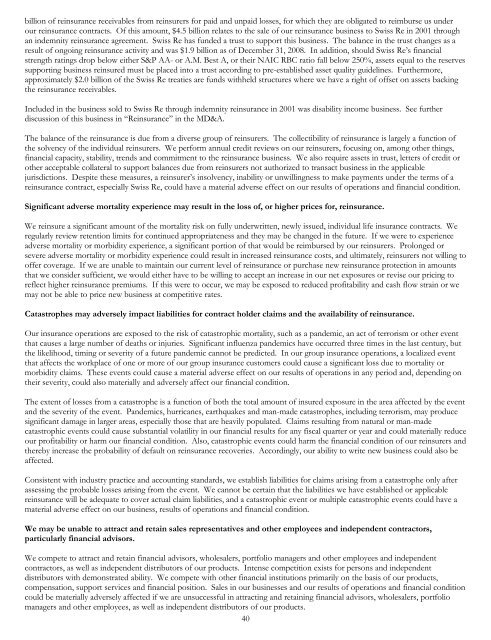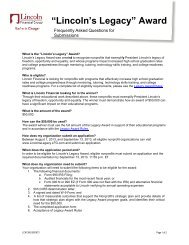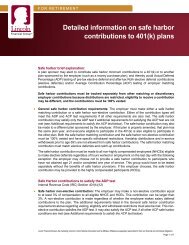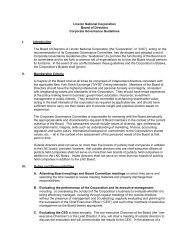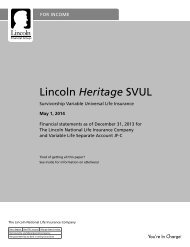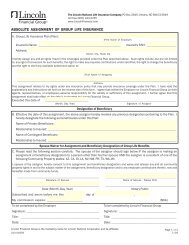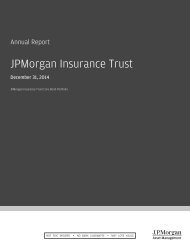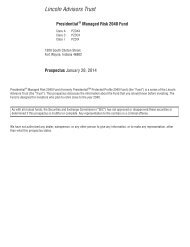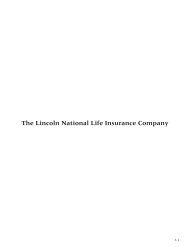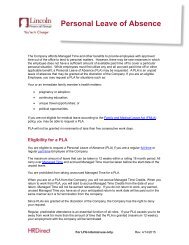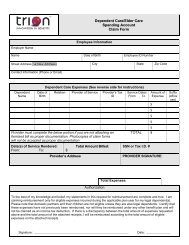2008 Annual Report to Shareholders - Lincoln Financial Group
2008 Annual Report to Shareholders - Lincoln Financial Group
2008 Annual Report to Shareholders - Lincoln Financial Group
You also want an ePaper? Increase the reach of your titles
YUMPU automatically turns print PDFs into web optimized ePapers that Google loves.
illion of reinsurance receivables from reinsurers for paid and unpaid losses, for which they are obligated <strong>to</strong> reimburse us under<br />
our reinsurance contracts. Of this amount, $4.5 billion relates <strong>to</strong> the sale of our reinsurance business <strong>to</strong> Swiss Re in 2001 through<br />
an indemnity reinsurance agreement. Swiss Re has funded a trust <strong>to</strong> support this business. The balance in the trust changes as a<br />
result of ongoing reinsurance activity and was $1.9 billion as of December 31, <strong>2008</strong>. In addition, should Swiss Re’s financial<br />
strength ratings drop below either S&P AA- or A.M. Best A, or their NAIC RBC ratio fall below 250%, assets equal <strong>to</strong> the reserves<br />
supporting business reinsured must be placed in<strong>to</strong> a trust according <strong>to</strong> pre-established asset quality guidelines. Furthermore,<br />
approximately $2.0 billion of the Swiss Re treaties are funds withheld structures where we have a right of offset on assets backing<br />
the reinsurance receivables.<br />
Included in the business sold <strong>to</strong> Swiss Re through indemnity reinsurance in 2001 was disability income business. See further<br />
discussion of this business in “Reinsurance” in the MD&A.<br />
The balance of the reinsurance is due from a diverse group of reinsurers. The collectibility of reinsurance is largely a function of<br />
the solvency of the individual reinsurers. We perform annual credit reviews on our reinsurers, focusing on, among other things,<br />
financial capacity, stability, trends and commitment <strong>to</strong> the reinsurance business. We also require assets in trust, letters of credit or<br />
other acceptable collateral <strong>to</strong> support balances due from reinsurers not authorized <strong>to</strong> transact business in the applicable<br />
jurisdictions. Despite these measures, a reinsurer’s insolvency, inability or unwillingness <strong>to</strong> make payments under the terms of a<br />
reinsurance contract, especially Swiss Re, could have a material adverse effect on our results of operations and financial condition.<br />
Significant adverse mortality experience may result in the loss of, or higher prices for, reinsurance.<br />
We reinsure a significant amount of the mortality risk on fully underwritten, newly issued, individual life insurance contracts. We<br />
regularly review retention limits for continued appropriateness and they may be changed in the future. If we were <strong>to</strong> experience<br />
adverse mortality or morbidity experience, a significant portion of that would be reimbursed by our reinsurers. Prolonged or<br />
severe adverse mortality or morbidity experience could result in increased reinsurance costs, and ultimately, reinsurers not willing <strong>to</strong><br />
offer coverage. If we are unable <strong>to</strong> maintain our current level of reinsurance or purchase new reinsurance protection in amounts<br />
that we consider sufficient, we would either have <strong>to</strong> be willing <strong>to</strong> accept an increase in our net exposures or revise our pricing <strong>to</strong><br />
reflect higher reinsurance premiums. If this were <strong>to</strong> occur, we may be exposed <strong>to</strong> reduced profitability and cash flow strain or we<br />
may not be able <strong>to</strong> price new business at competitive rates.<br />
Catastrophes may adversely impact liabilities for contract holder claims and the availability of reinsurance.<br />
Our insurance operations are exposed <strong>to</strong> the risk of catastrophic mortality, such as a pandemic, an act of terrorism or other event<br />
that causes a large number of deaths or injuries. Significant influenza pandemics have occurred three times in the last century, but<br />
the likelihood, timing or severity of a future pandemic cannot be predicted. In our group insurance operations, a localized event<br />
that affects the workplace of one or more of our group insurance cus<strong>to</strong>mers could cause a significant loss due <strong>to</strong> mortality or<br />
morbidity claims. These events could cause a material adverse effect on our results of operations in any period and, depending on<br />
their severity, could also materially and adversely affect our financial condition.<br />
The extent of losses from a catastrophe is a function of both the <strong>to</strong>tal amount of insured exposure in the area affected by the event<br />
and the severity of the event. Pandemics, hurricanes, earthquakes and man-made catastrophes, including terrorism, may produce<br />
significant damage in larger areas, especially those that are heavily populated. Claims resulting from natural or man-made<br />
catastrophic events could cause substantial volatility in our financial results for any fiscal quarter or year and could materially reduce<br />
our profitability or harm our financial condition. Also, catastrophic events could harm the financial condition of our reinsurers and<br />
thereby increase the probability of default on reinsurance recoveries. Accordingly, our ability <strong>to</strong> write new business could also be<br />
affected.<br />
Consistent with industry practice and accounting standards, we establish liabilities for claims arising from a catastrophe only after<br />
assessing the probable losses arising from the event. We cannot be certain that the liabilities we have established or applicable<br />
reinsurance will be adequate <strong>to</strong> cover actual claim liabilities, and a catastrophic event or multiple catastrophic events could have a<br />
material adverse effect on our business, results of operations and financial condition.<br />
We may be unable <strong>to</strong> attract and retain sales representatives and other employees and independent contrac<strong>to</strong>rs,<br />
particularly financial advisors.<br />
We compete <strong>to</strong> attract and retain financial advisors, wholesalers, portfolio managers and other employees and independent<br />
contrac<strong>to</strong>rs, as well as independent distribu<strong>to</strong>rs of our products. Intense competition exists for persons and independent<br />
distribu<strong>to</strong>rs with demonstrated ability. We compete with other financial institutions primarily on the basis of our products,<br />
compensation, support services and financial position. Sales in our businesses and our results of operations and financial condition<br />
could be materially adversely affected if we are unsuccessful in attracting and retaining financial advisors, wholesalers, portfolio<br />
managers and other employees, as well as independent distribu<strong>to</strong>rs of our products.<br />
40


